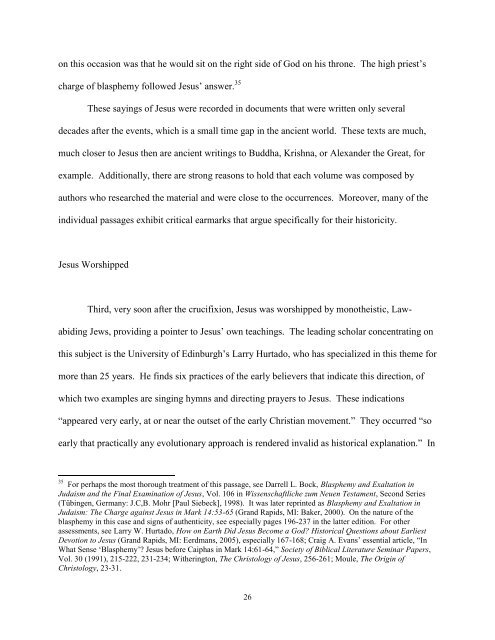Published by
299z7CN
299z7CN
You also want an ePaper? Increase the reach of your titles
YUMPU automatically turns print PDFs into web optimized ePapers that Google loves.
on this occasion was that he would sit on the right side of God on his throne. The high priest’s<br />
charge of blasphemy followed Jesus’ answer. 35<br />
These sayings of Jesus were recorded in documents that were written only several<br />
decades after the events, which is a small time gap in the ancient world. These texts are much,<br />
much closer to Jesus then are ancient writings to Buddha, Krishna, or Alexander the Great, for<br />
example. Additionally, there are strong reasons to hold that each volume was composed <strong>by</strong><br />
authors who researched the material and were close to the occurrences. Moreover, many of the<br />
individual passages exhibit critical earmarks that argue specifically for their historicity.<br />
Jesus Worshipped<br />
Third, very soon after the crucifixion, Jesus was worshipped <strong>by</strong> monotheistic, Lawabiding<br />
Jews, providing a pointer to Jesus’ own teachings. The leading scholar concentrating on<br />
this subject is the University of Edinburgh’s Larry Hurtado, who has specialized in this theme for<br />
more than 25 years. He finds six practices of the early believers that indicate this direction, of<br />
which two examples are singing hymns and directing prayers to Jesus. These indications<br />
“appeared very early, at or near the outset of the early Christian movement.” They occurred “so<br />
early that practically any evolutionary approach is rendered invalid as historical explanation.” In<br />
35 For perhaps the most thorough treatment of this passage, see Darrell L. Bock, Blasphemy and Exaltation in<br />
Judaism and the Final Examination of Jesus, Vol. 106 in Wissenschaftliche zum Neuen Testament, Second Series<br />
(Tübingen, Germany: J.C,B. Mohr [Paul Siebeck], 1998). It was later reprinted as Blasphemy and Exaltation in<br />
Judaism: The Charge against Jesus in Mark 14:53-65 (Grand Rapids, MI: Baker, 2000). On the nature of the<br />
blasphemy in this case and signs of authenticity, see especially pages 196-237 in the latter edition. For other<br />
assessments, see Larry W. Hurtado, How on Earth Did Jesus Become a God? Historical Questions about Earliest<br />
Devotion to Jesus (Grand Rapids, MI: Eerdmans, 2005), especially 167-168; Craig A. Evans’ essential article, “In<br />
What Sense ‘Blasphemy’? Jesus before Caiphas in Mark 14:61-64,” Society of Biblical Literature Seminar Papers,<br />
Vol. 30 (1991), 215-222, 231-234; Witherington, The Christology of Jesus, 256-261; Moule, The Origin of<br />
Christology, 23-31.<br />
26


